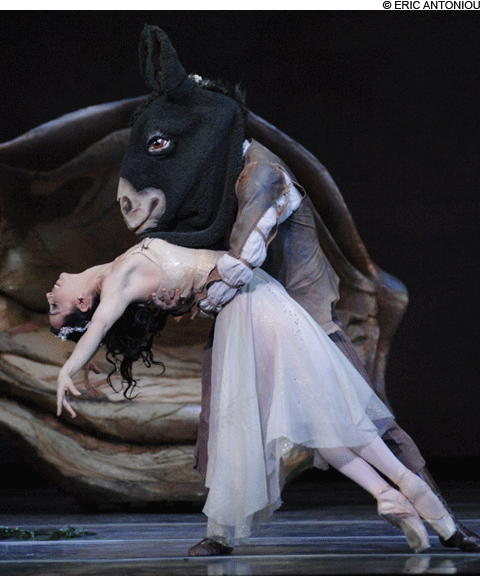
DONKEY DREAMS Robert Kretz’s Bottom has his hands full with Lorna Feijóo’s smitten Titania. |
George Balanchine didn’t create a slew of full-length ballets, but it’s easy to see why a setting of Shakespeare’s ever-popular A Midsummer Night’s Dream is one of them — and not just because, back home in St. Petersburg, when he was eight, he played a bug in a theater production of the Bard’s moonbeam-muddled comedy. The play has a surfeit of good roles for dancers: speedy Puck; noble duke Theseus and his Amazonian bride-to-be, Hippolyta, and their fairy counterparts, Oberon and Titania (often doubled in on the theater stage, but not here); the four mix-and-match lovers, Hermia, Lysander, Helena, and Demetrius; the rustic mechanicals headed by carpenter Nick Bottom; and the legions of fairies that can be played by adults or children. Balanchine made his usual magic out of it, and Boston Ballet, reprising its 2007 production (but with different costumes and sets), makes magic out of Balanchine, with Lorna Feijóo melting her donkey’s heart last night and Larissa Ponomarenko and James Whiteside melting the audience in their second-act pas de deux.
The problem with any evening-length Midsummer is finding an evening length’s worth of music. The score that Felix Mendelssohn wrote to accompany an 1843 theater staging is so luscious that no one wants to hear anything else, but there’s only an hour of it. Balanchine fleshed that out with about 30 minutes of lesser Mendelssohn. The first act of his ballet retells the story, including a duet for Titania and her “Cavalier” (a Balanchine invention) set to Mendelssohn’s Athalia Overture. After intermission, there’s a half-hour Divertissement, a benediction from moon goddess Phoebe, with an extended pas de deux (Apollo and Phoebe herself?) set to the Andante from Mendelssohn’s Sinfonia No. 9 followed by spotlight dances for the three newlywed couples. Balanchine had limited interest in the narrative, or even the relationships: the mechanicals get very short shrift; the lovers don’t do much better; Oberon and Titania promenade but never actually dance together. And if you’re wondering whether what goes on in Titania’s bower will be R-rated: Bottom as donkey settles down next to it, not in it.
>> Photos: Boston Ballet's A Midsummer Night's Dream <<
One point of interest last night lay in whether corps member Jeffrey Cirio as Puck could repeat his extraordinary success in the past two weekends’ Elo Experience. He did, putting a girdle around the stage in less than 40 seconds and getting a hint of subversion into his limited role. Dancing Titania, Feijóo didn’t look comfortable with her Cavalier (Lorin Mathis), but, as in 2007, she was superbly playful and tender with her donkey, whom Robert Kretz portrayed with touching innocence. John Lam was a commanding Oberon with more than decent brisés volés; of the four well-matched lovers — Erica Cornejo as Hermia, Pavel Gurevich as Lysander, Kathleen Breen Combes as Helena, and Yury Yanowsky as Demetrius — it was Breen Combes and Yanowsky who made the most of their silent-movie melodrama. Lia Cirio was an athletic Hippolyta with bounding split jetés, and in the Divertissement, she got good support from Bo Busby as her Theseus. Dalay Parrondo was the charming leader of a charming assortment of children playing butterflies and fairies. Ponomarenko and Whiteside, both individually and together, gave a master class in how to make Mr. B’s simplest moves look exquisite.